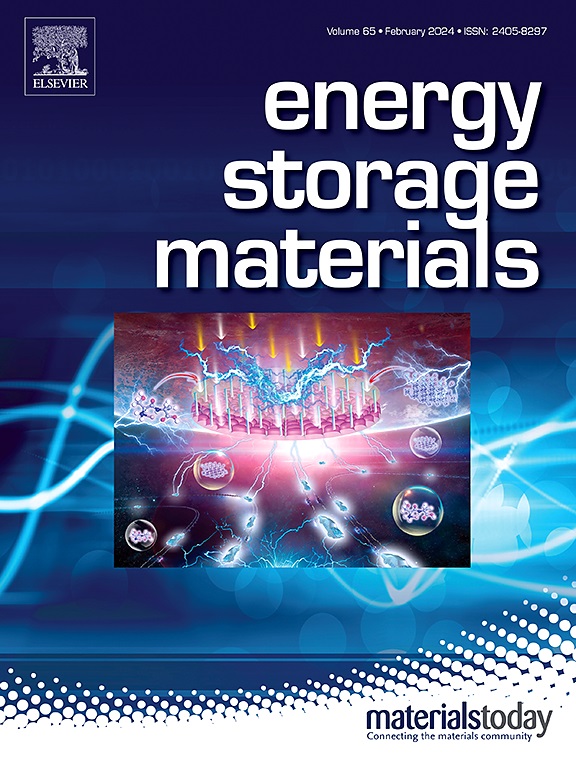Advancing sodium-ion batteries toward commercialization: A review on phosphate and sulfate-based polyanionic cathodes
IF 20.2
1区 材料科学
Q1 CHEMISTRY, PHYSICAL
引用次数: 0
Abstract
Sodium-ion batteries (SIBs) are considered as a promising supplement to lithium-ion batteries for large-scale energy storage applications due to the abundance and cost-effectiveness of sodium resources. Among various cathode materials, polyanionic compounds, particularly phosphate and sulfate-based ones, have garnered significant attention for their good structural stability, high redox potentials, and favorable Na+x002B diffusion channels. However, challenges such as low electronic conductivity, limited capacity, and complex synthesis procedures hinder their widespread application. This review starts with the key characteristics of polyanionic materials, followed by a thorough summary of recent advancements in phosphate and sulfate-based cathodes, emphasizing their crystal structures, electrochemical properties, and sodium storage mechanisms. Then, the preparation methods and advanced modification strategies, including surface coating, particle size engineering, morphology and interface design, and element doping, are reviewed in detail. By systematically comparing phosphates and sulfates, this review integrates their commercialization progress and application scenarios from an industry-oriented perspective. This highlights the importance of industry-academia collaboration in accelerating the transition of polyanionic cathode materials from laboratory research to practical applications. Finally, future research directions and innovative approaches are proposed to overcome existing challenges, paving the way for the practical deployment of these materials in next-generation sustainable energy storage systems.
推进钠离子电池商业化:磷酸盐和硫酸盐基多阴离子阴极研究进展
由于钠资源丰富且具有成本效益,钠离子电池被认为是锂离子电池大规模储能应用的一个有前景的补充。在各种正极材料中,聚阴离子化合物,特别是磷酸盐和硫酸盐基化合物,因其良好的结构稳定性、高的氧化还原电位和良好的Na+扩散通道而备受关注。然而,诸如低电子导电性、有限的容量和复杂的合成过程等挑战阻碍了它们的广泛应用。本文首先介绍了聚阴离子材料的主要特性,然后全面总结了磷酸盐和硫酸盐基阴极的最新进展,重点介绍了它们的晶体结构、电化学性能和钠储存机制。然后,详细介绍了制备方法和先进的改性策略,包括表面涂层、粒径工程、形貌和界面设计以及元素掺杂。本文通过对磷酸盐和硫酸盐的系统比较,从工业的角度对其商业化进展和应用前景进行了综述。这凸显了产学合作在加速多阴离子正极材料从实验室研究到实际应用的转变中的重要性。最后,提出了未来的研究方向和创新方法,以克服现有的挑战,为这些材料在下一代可持续储能系统中的实际部署铺平了道路。
本文章由计算机程序翻译,如有差异,请以英文原文为准。
求助全文
约1分钟内获得全文
求助全文
来源期刊

Energy Storage Materials
Materials Science-General Materials Science
CiteScore
33.00
自引率
5.90%
发文量
652
审稿时长
27 days
期刊介绍:
Energy Storage Materials is a global interdisciplinary journal dedicated to sharing scientific and technological advancements in materials and devices for advanced energy storage and related energy conversion, such as in metal-O2 batteries. The journal features comprehensive research articles, including full papers and short communications, as well as authoritative feature articles and reviews by leading experts in the field.
Energy Storage Materials covers a wide range of topics, including the synthesis, fabrication, structure, properties, performance, and technological applications of energy storage materials. Additionally, the journal explores strategies, policies, and developments in the field of energy storage materials and devices for sustainable energy.
Published papers are selected based on their scientific and technological significance, their ability to provide valuable new knowledge, and their relevance to the international research community.
 求助内容:
求助内容: 应助结果提醒方式:
应助结果提醒方式:


